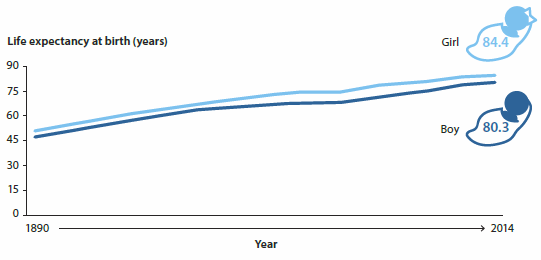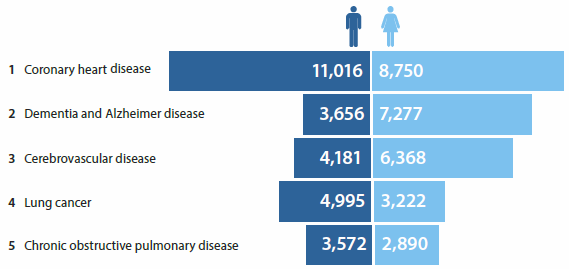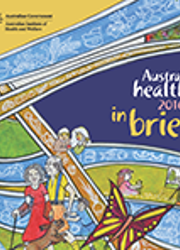Are we a healthy nation?
One measure of health is life expectancy—and on that score Australia performs particularly well. But there are many other ways to look at health, such as how many of us are living with a chronic disease, and how many 'healthy' years we are losing to ill health.
We are feeling good
In 2014-15, 85% of Australians aged 15 and over self-rated their health as 'good' or better. This was similar to the proportion recorded in 2011-12.
Australia is one of the leading countries on this measure—among 34 Organisation for Economic Cooperation and Development (OECD) countries we rank only behind New Zealand (90%), Canada (89%) and the United States (88%), and we rank higher than the OECD average of 69%.
More than half (56%) of Australians rated their health as 'excellent' or 'very good'. Just over 1 in 10 (10.4%) Australians rated their health as 'fair' (10.7% in 2011-12), and 4.4% as 'poor' (4.0% in 2011-12).
By comparison, only 39% of Indigenous Australians rated their health as 'excellent' or 'very good' in 2012-13—a decrease from 44% in 2008 and 43% in 2004-05. A further 37% reported their health as 'good', 17% as 'fair' and 7% as 'poor' in 2012-13.
Adjusting for differences in age structure, 29% of Indigenous Australians rated their health as 'fair' or 'poor', more than double the non-Indigenous rate of 14%.
And living longer than ever before
A boy born between 2012 and 2014 can expect to live to 80.3 years and a girl to 84.4 years. This compares with life expectancies at birth of 67.1 and 72.8 years, respectively, for those born in 1955; and 47.2 and 50.8 years, respectively, for those born in 1890.
Life expectancy at birth by sex, Australia, 1890 to 2014

Males who had survived to the age of 65 in 2014 could expect to live, on average, another 19.4 years (to 84.4 years) and females an extra 22.2 years (to 87.2).
The concept of what it means to be 'healthy' encompasses not just how many years a person lives, but whether those years are lived with disability, chronic illness, or other health conditions that affect quality of life.
In 2012, a newborn boy in Australia could expect to live 62.4 years without disability and another 17.5 years with some form of disability, including 5.6 years with severe or profound core activity limitation. Girls born in 2012 could expect to live 64.5 years without disability and 19.8 years with some form of disability, including 7.8 years with severe or profound core activity limitation.
For the first time, cancer is our biggest overall killer
In 2013, nearly 147,700 deaths were registered in Australia.
For the first time, the total number of deaths due to all types of cancer combined (44,100) surpassed the total number of deaths due to cardiovascular disease (which includes coronary heart disease, stroke and heart failure) (43,600). However, coronary heart disease continues to be the leading specific cause of death in Australia (19,800 deaths in 2013).
Leading causes of death, by sex, Australia, 2013

...and also accounts for the biggest burden
'Burden of disease' comprises both the burden of living with ill health and the burden of dying prematurely, and it is measured in 'disability-adjusted life years' (DALY). One DALY is one year of 'healthy life' lost due to illness and/or death.
Overall, in 2011, for every 1,000 people in Australia, there were 201 years of healthy life lost due to dying or living with disease or injury. This was equivalent to 4.5 million DALY in total.
Cancer; cardiovascular disease; mental and substance-use disorders; musculoskeletal disorders; and injury contributed most to the burden of disease in Australia in 2011 —together they accounted for around two-thirds of the total burden (69% of the burden for males, 62% of the burden for females).
Between 2003 and 2011, using age-standardised rates, the burden of disease for the Australian population decreased by 10%.
Burden of disease, by disease group, Australia, 2011

Burden of disease changes throughout life
The various life stages between childhood and death are accompanied by different health challenges.
This table shows the leading causes of fatal, non-fatal and total burden of disease for Australian males and females, from infancy to older age groups. The table shows the top-ranked condition only.
| Males | Under 5 | 5-14 | 15-24 | 25-44 | 45-64 | 65-74 | 75-84 | 85+ |
|---|---|---|---|---|---|---|---|---|
| Leading cause of fatal burden | Pre-term/low birthweight complications | Road traffic injuries/ accidents | Suicide | Suicide | Coronary heart disease | Coronary heart disease | Coronary heart disease | Coronary heart disease |
| Leading cause of non-fatal burden | Asthma | Asthma | Alcohol use disorders | Back pain | Other musculoskeletal conditions | Chronic obstructive pulmonary disease | Coronary heart disease | Dementia |
| Leading cause of total burden | Pre-term/low birthweight complications | Asthma | Suicide/ intentional self-harm | Suicide/ intentional self-harm | Coronary heart disease | Coronary heart disease | Coronary heart disease | Coronary heart disease |
| Females | Under 5 | 5-14 | 15-24 | 25-44 | 45-64 | 65-74 | 75-84 | 85+ |
|---|---|---|---|---|---|---|---|---|
| Leading cause of fatal burden | Birth trauma/ asphyxia | Brain/ central nervous system cancer | Suicide | Suicide | Breast cancer | Lung cancer | Coronary heart disease | Coronary heart disease |
| Leading cause of non-fatal burden | Other mental disorders | Anxiety disorders | Anxiety disorders | Anxiety disorders | Other musculoskeletal conditions | Other musculo-skeletal conditions | Dementia | Dementia |
| Leading cause of total burden | Birth trauma/ asphyxia | Anxiety disorders | Anxiety disorders | Anxiety disorders | Other musculoskeletal conditions | Coronary heart | Coronary heart disease | Dementia |
Many of us have a chronic disease
Chronic diseases are the leading cause of ill health, disability and death in Australia, and have a significant impact on the health system. In 2014-15, based on self-reported data from the National Health Survey, more than 11 million Australians (50%) had at least 1 of 8 selected chronic diseases: arthritis; asthma; back pain and problems; cancer; cardiovascular disease; chronic obstructive pulmonary disease; diabetes; and mental health conditions.
This rate was higher for:
- People aged 65 and over (87%) compared with people aged 0-44 (35%)
- Females (52%) compared with males (48%)
- People in the lowest socioeconomic areas (55%) compared with those in the highest socioeconomic areas (47%)
- People living in Regional and Remote areas (54%) compared with those in Major cities (48%).
Overall, 1 in 4 (23%) Australians—5.3 million people—had 2 or more of the 8 selected chronic diseases.
Cardiovascular disease (18%) and mental health conditions (18%) were the most commonly reported of the selected chronic diseases, followed by back pain and problems (16%).
Chronic diseases can have large impacts on quality of life and can have social and economic effects. The eight selected chronic diseases were associated with:
- Over 7 in 10 (73%) deaths in 2013
- Around 1 in 3 (30%) problems managed in general practices in 2014-15
- More than 1 in 3 (39%) potentially preventable hospitalisations in 2013-14
- More than three-fifths (61%) of the total burden of disease in 2011.



